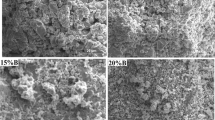Abstract
In this work a radiospectroscopic investigation of the B-C, B-C-Ti and B-C-Cr systems was made in the range of 0 to 30 at % carbon at 4.2, 77 and 300 K. It is shown that in the B-C system, with a change of carbon content from 0 to 30% there are two concentration ranges in which a change occurs in the character of EPR signal: the first from 0 to 13% carbon and the second where the carbon content is 18 to 30%. The g factor, the width, the form and the intensity of EPR lines indicate that in the first range the EPR signal is due to the B12C complexes, which represent the lattice of α-boron with one carbon atom. In the second range the experimental data indicate that probably the introduction of four carbon atoms occurs, so that the formation of B12C4 centres is in question. The change in intensity of the signal on introduction and increase of titanium and chromium contents indicates different mechanisms of interaction of the basic components in this system. Keeping in mind that with increasing content of addition the microhardness of samples increases, while the intensity of the EPR signal decreases, it is probable that larger amounts of the B13C2-phase, which is characterized by a higher microhardness, are then formed.
Similar content being viewed by others
References
Q. V. Samsonov, L. Ja. Markovskii, A. F. Zhigach, and M. G. Valjashko, “Bor, ego soedinenija i splavi” (Izd vo AN USSR, Kiev, 1960).
B. F. Decker and J. S. Kasber, Acta Crystallogr 12 (1959) 503.
W. Klein and D. Geist, Z. Physik 201 (1967) 411.
D. Geist, J. Meyer and H. Peussner, “Boron-Preparation and Properties”, Vol. 3, Proceedings of the International Symposium on Boron, Warsaw (1968) p. 213.
J. J. Koulmann, N. Perol and P. Taglang, Compt. Rend. 267 (1368) B15.
J. J. Koulmann, G. Kappel and P. Taglang, ibid 270 (1970) B445.
G. Feher and A. Kip, Phys. Rev. 98 (1955) 337.
N. N. Zhuravlev, G. N. Makarenko, G. V. Samsonov, V. S. Sineljnikova and G. G. Cebulja, Izv. SSSR, Ser Metallurg. Toplivo, 1 (1961) 133.
Z. Vinter, “Magnitnii Rezonans v Metallah” (Mir, Moscow, 1976).
Author information
Authors and Affiliations
Rights and permissions
About this article
Cite this article
Vlasova, M.V., Kakazey, N.G., Kosolapova, T.Y. et al. The structure of paramagnetic centres and the formation of defects in the B-C, B-C-Ti and B-C-Cr systems. J Mater Sci 15, 1041–1048 (1980). https://doi.org/10.1007/BF00552118
Received:
Accepted:
Issue Date:
DOI: https://doi.org/10.1007/BF00552118




